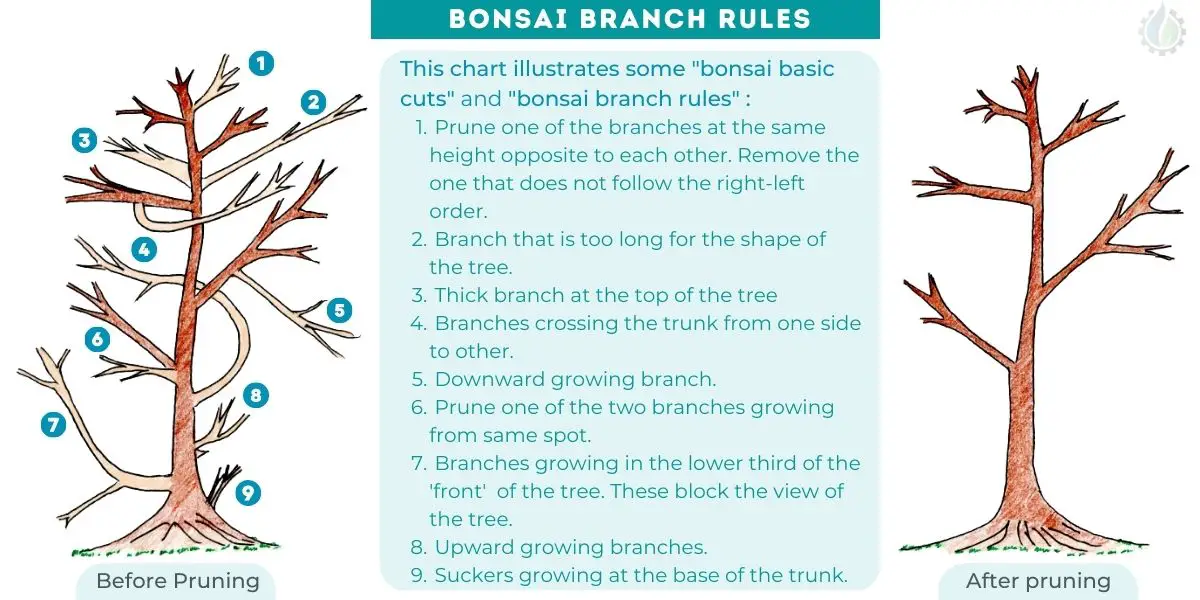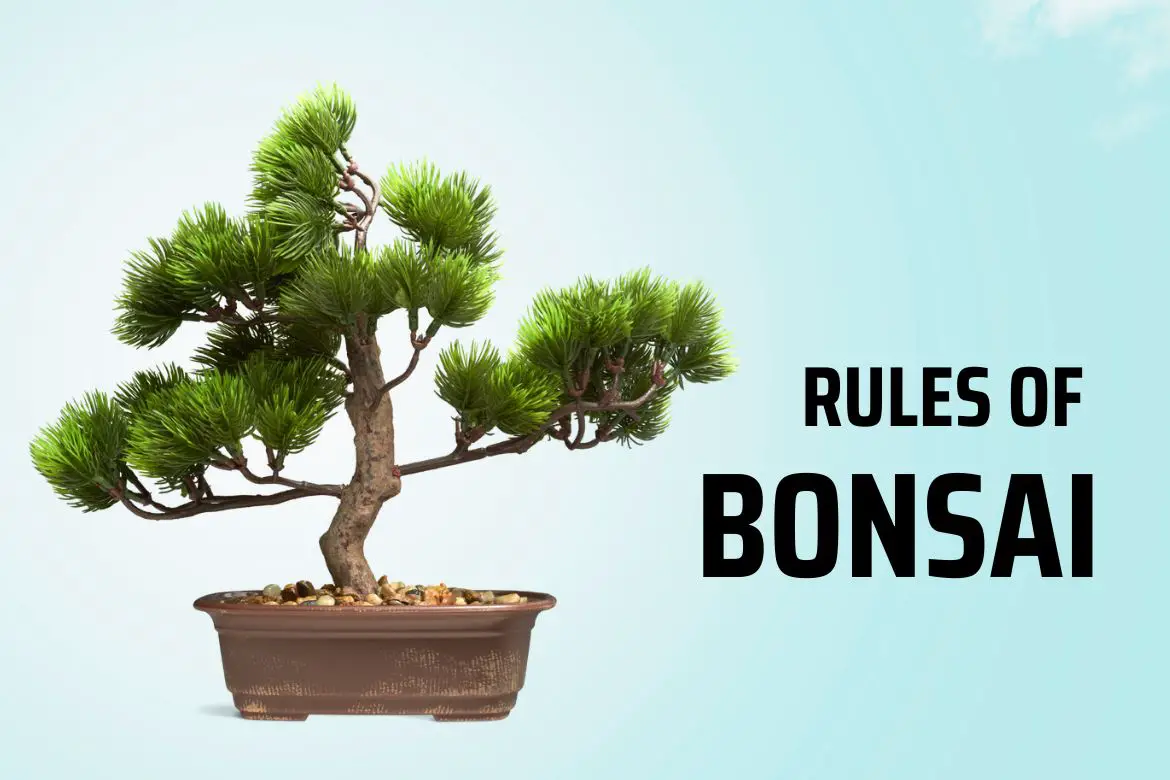There are certain rules to follow when creating a bonsai. It is true that you can add some creativity, but the guidelines are in place for a reason. These “rules” will be invaluable as you learn how to grow and train bonsai. Thanks to so much historical information passed down from China and Japan, a lot of guesswork is eliminated for you.
It is important to remember that bonsai rules are in most cases intended only as a guide and do not necessarily have to be strictly followed. Taking inspiration from nature is a good idea, since bonsai styles aren’t invented, but rather recreate the way trees grow in their natural settings.
Rules of bonsai can be divided into 4 sub-categories : Trunk rules, branch rules, pot rules and culture rules.
Bonsai Trunk Rules

More details on all the bonsai styles and shapes.
- It is recommended that the trunk leans slightly in the direction of the viewer when displayed
- It is recommended that the trunk of the bonsai be slightly flared at the base to anchor its visual look
- The overall height of the Bonsai should be six times the height of the trunk’s caliper
- It is important that the roots radiate from the flare of the trunk
- In addition, the apex should also lean towards the viewer.
- The trunk should begin to taper as it ascends
- A viewer should not be able to see any roots poking out at their level when viewing
- A good rule of thumb is that all grafts should match the scion and the understock of the tree, which will keep them from being overpowering
- Ensure that the trunk’s curves are not rounded at eye level
- The apex should always end in the same direction as the base, and the flow should be maintained in that direction
- It is important that the trunk line never reverts back in on itself – although it is difficult to understand, it has to do with the tree’s balance and flow. A “C” shape would be formed if the trunk were to turn back on itself.
- Keep the “S” shape to a minimum for the Informal Upright style. Rather than having two dimensional curves, try and have more of a three dimensional feel to the tree.
- As a general rule, the apex of the Information and Formal Upright styles should be more or less in line with the base of the tree.
- There should be only one apex on the bonsai tree
- A twin trunk should be divided at the base and not higher than that
- As a tree ascends, the curves should become more closely spaced
Bonsai branch rules

Detailed guide on pruning a bonsai tree.
- Trunks and branches should not cross each other
- Crossing branches should be avoided
- Branch tips should not point toward the viewer’s angle
- Branches should be on the outside of curves
- About one third up the tree’s height, the first branch should be located.
- The first branch should be on the left or right side, followed by the next branch on the opposite side. Therefore, the branches should follow left, right, left, right, (or vice versa) pattern.
- The branch caliper must be proportional to the trunk caliper.
- Branches that are thicker than one-third the trunk’s caliper are considered too thick
- Branches should be visually alternated, not parallel
- As branches ascend, their size and caliper should decrease
- It is important for the branches to have space between them to give the impression that birds could fly through
- First and second branches should be forward of the mid-line
- For each trunk position, only one branch should be present. There should be no whorled branches, branches opposite each other, or spoke or wheel branches.
- You want the first, second, and third branches to be 120 degrees apart, making sure the back branch isn’t directly behind the tree
- The placement of any secondary branches should follow the same alternating placement rules as the main branches. In this way, foliage pads can be created.
- The branches should form a scalene triangle with the apex. The apex signifies heaven, the middle corner signifies man, and the lower corner signifies earth.
- The branches in the Cascade style will usually follow the same rules as those in the Upright style, except the trunk will move downward.
- The goal of Bonsai is to make the tree look old. Branches need to be wired and trained in the desired style to accomplish this.
- Branches between twin trees should not cross each other’s trunks
- Make sure there is no Jin hiding in the foliage
Bonsai pot rules

Read the detailed guide on how to choose a bonsai pot for your bonsai.
- Unless it’s a cascade style, the pot’s depth should match the trunk’s caliper
- Pot the bonsai a little off-center in the center-line of the bonsai pot
- For fruiting bonsai tree and flowering bonsai trees, select colorful glazed pots. These will add to the beauty of the bonsai.
- Pots should have a width two-thirds that of the tree’s height. When the tree is short, the pot should cover two-thirds of the tree’s spread
- Trees should always be potted in a style that matches their pots. As an example, if you decide that you want to train your Bonsai in the upright style, then you may want to consider getting a rectangular pot for your Bonsai. In the case of an Informal Upright style bonsai, then the pot should either be round or oval.
Bonsai culture rules
- When fertilizing, you should ensure the fertilizer is at full strength (Remember that these are old rules. Now we follow different bonsai feeding practices. In many cases, we use half strength or diluted fertilizers.) Read detailed guide on applying feed to a bonsai.
- The soil should always be uniform and should not be layered (Again, this is an old rule. Layering the soil definitely helps the bonsai tree, specially in drainage of water. and absorption of nutrients). Read detailed guide on bonsai soil and homemade bonsai soil recipes.
- By placing a simple tray of small pebbles covered with water by the base of the tree, you will help to increase the level of humidity in the room (You can also do this by placing a tub of water under the bench of the tree).
- In spite of the fact that an occasional misting of the leaves is not necessarily a bad thing, you need to be aware that it may cause a salt buildup on the leaves in the long run. (also the foliage of the tree becomes more susceptible to scorching.)
- Instead of watering your Bonsai on a fixed schedule, you should pay attention to the moisture level of your plant and water it as needed. Please read watering a bonsai tree for more details.
- A bonsai soil mix should be removed of fine particles so that only coarse particles remain
- Plants from tropical and subtropical climates should be considered for indoor Bonsai, while plants from temperate climates do best outside. In order to keep temperate climate plants indoors, you will need to ensure that they are provided with a certain amount of cold dormancy during the winter months.

